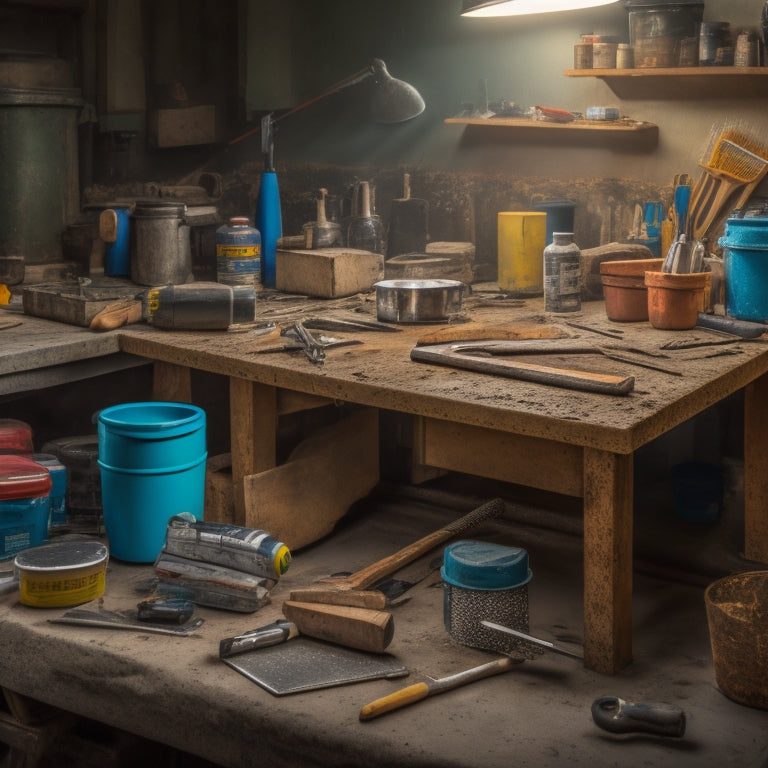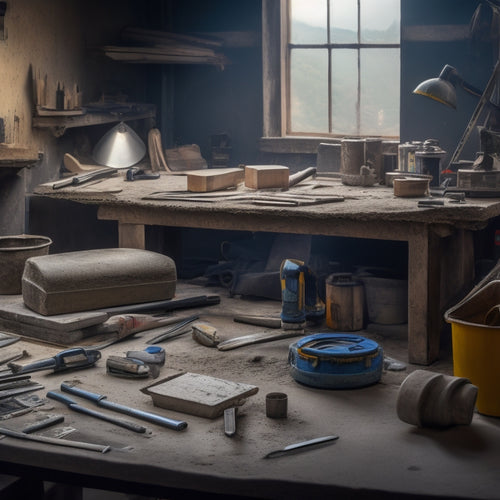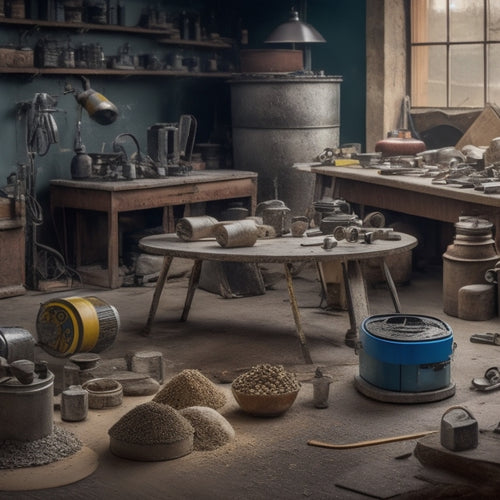
Essential Tools for Filling Concrete Cracks DIY
Share
You'll need a diverse range of specialized tools to successfully fill concrete cracks DIY, from crack inspection tools like magnifying glasses and crack inspection lenses, to concrete surface preparation equipment like wire brushes and concrete grinders. Epoxy injection guns, caulk guns, and chiseling tools are also essential for precise application and removal of debris. Additionally, you'll require safety gear like goggles, dust masks, and gloves to protect yourself from chemicals and rough surfaces. With the right tools and equipment, you'll be well-prepared to tackle the task at hand, and mastering the techniques and strategies that follow will guarantee a successful repair.
Key Takeaways
• Identify the type of crack (hairline, structural, or settlement) to choose the right repair method and tools.
• Prepare the concrete surface by cleaning, roughening, and vacuuming to ensure a strong bond with the repair material.
• Select the appropriate epoxy injection equipment, crack filling material applicators, and chiseling tools based on crack size and type.
• Use safety gear and protective equipment, such as goggles, dust masks, and gloves, to prevent injuries and exposure to chemicals.
• Follow a step-by-step process, from inspection to finishing techniques, to ensure a successful and long-lasting concrete crack repair.
Crack Inspection and Cleaning Tools
Before filling concrete cracks, inspect the cracks thoroughly with a magnifying glass or crack inspection lens to identify their length, width, and depth, and to detect any signs of damage or deterioration.
You'll want to determine the type of crack you're dealing with, whether it's a hairline crack, a structural crack, or a settlement crack. This will help you choose the right repair method and materials.
When inspecting the cracks, use a combination of visual inspection methods, such as tapping the surface gently with a hammer to detect hollow sounds, and using a flashlight to illuminate the crack.
You may also use non-destructive testing methods like ground-penetrating radar or infrared thermography to gather more detailed information.
It's essential to identify the source of the crack and assess its severity to guarantee a successful repair.
Concrete Surface Preparation Tools
You'll need to prepare the concrete surface around the crack by cleaning and roughening it to secure a strong bond between the old concrete and the repair material. This step is essential, as it guarantees the concrete repair products adhere properly.
For surface preparation, you'll require a wire brush or a stiff-bristled broom to remove dirt, oil, or other contaminants that might interfere with the bonding process. Next, use a concrete grinder or a scarifier to roughen the surface, creating a texture that allows the repair material to grip. Be sure to vacuum the area thoroughly to remove any dust or debris generated during the process.
When selecting surface preparation techniques, consider the type of crack you're dealing with and the surrounding concrete's condition. For instance, if the crack is particularly deep or wide, you may need to use a more aggressive technique to achieve the desired surface roughness.
Epoxy Injection Equipment Needed
Your epoxy injection kit should include a high-pressure injection gun, suitable for injecting epoxy into the crack at a pressure of around 3000-4000 psi. This gun is the core of your epoxy injection equipment and is responsible for delivering the epoxy resin into the crack.
| Epoxy Type | Viscosity | Recommended Gun Pressure |
|---|---|---|
| Low-viscosity epoxy | 100-200 cP | 2000-2500 psi |
| Medium-viscosity epoxy | 200-500 cP | 2500-3000 psi |
| High-viscosity epoxy | 500-1000 cP | 3000-4000 psi |
When selecting an epoxy type, consider the crack's width and depth, as well as the surrounding concrete's condition. Make sure you follow the manufacturer's guidelines for the recommended gun pressure and epoxy type. Regular equipment maintenance is vital to guarantee the longevity of your epoxy injection kit. Clean the gun and hoses after each use, and store them in a dry, protected area. Proper maintenance will prevent clogs and guarantee consistent epoxy flow. By choosing the right epoxy type and maintaining your equipment, you'll achieve professional-grade results in your DIY concrete crack repair project.
Crack Filling Material Applicators
When it comes to applying crack filling materials, you'll need the right tools to guarantee a precise and efficient process.
You'll want to familiarize yourself with caulk gun essentials, including the types of guns and their compatible cartridges, as well as tube nozzle options that allow for varying degrees of precision.
Caulk Gun Essentials
A caulk gun is an indispensable tool for efficiently applying crack filling materials, allowing you to dispense the exact amount of sealant required directly into the crack.
As you prepare to tackle your concrete repair project, it's essential to choose the right caulk gun for the job. There are several caulk gun types to evaluate, including manual, pneumatic, and battery-powered models. Each type has its own advantages and disadvantages, so be sure to select the one that best suits your needs.
Proper caulk gun maintenance is also critical to guarantee peak performance and extend the life of your tool. Regularly clean the gun's nozzle and barrel to prevent clogs and dried sealant buildup.
Also, lubricate the gun's moving parts to keep them running smoothly. Additionally, inspect the gun's seals and O-rings for signs of wear and replace them as needed.
Tube Nozzle Options
You'll need to pair your caulk gun with the right tube nozzle option to confirm precise application of crack filling materials, as this attachment determines the flow rate and pattern of the sealant.
When selecting a tube nozzle, consider the type of crack you're filling and the viscosity of the material. There are various tube nozzle types, including cone nozzles for large cracks, fan nozzles for wide surface areas, and needle nozzles for small, tight spaces.
Nozzle size considerations are also essential. A smaller nozzle size allows for more precise application, while a larger nozzle size increases the flow rate.
Make sure to choose a nozzle that matches the size of the crack and the required flow rate. A mismatch can lead to uneven application, wasting material and time.
Additionally, consider the material's pressure requirement and the nozzle's pressure rating to confirm smooth operation.
Spout Extension Tips
Fit your caulk gun with spout extension tips, also known as crack filling material applicators, to extend your reach and maneuver into tight spaces, allowing for more accurate and controlled application of sealants.
These spout extensions come in various types, including flexible and rigid options, each designed to suit specific crack filling needs. The flexible spout extension, for instance, is ideal for curved or irregularly shaped cracks, while the rigid spout extension is better suited for straight cracks or joints.
The benefits of using spout extension tips are numerous. They enable you to access hard-to-reach areas, such as deep cracks or areas with limited clearance, without having to contort your body or use additional equipment. This results in reduced fatigue and improved productivity.
Additionally, spout extensions provide a more precise application of sealants, reducing waste and mess. By using spout extension tips, you'll be able to complete your crack filling project more efficiently and effectively, ensuring a professional-looking finish and a longer-lasting repair.
Chiseling and Scraping Tools Required
When preparing to fill concrete cracks, gather a set of chiseling and scraping tools, as these are vital for effectively removing loose debris and crumbling concrete from the crack. You'll need to master chiseling techniques and scraping methods to guarantee a clean and stable surface for filling.
Here's a list of the chiseling and scraping tools you'll need:
| Tool | Description | Purpose |
|---|---|---|
| Cold chisel | A flat, broad chisel for breaking up concrete | Removing large chunks of debris |
| Pointed chisel | A pointed chisel for precision work | Scraping out small areas of crumbling concrete |
| Wire brush | A stiff-bristled brush for sweeping away debris | Cleaning the crack surface |
Using the right chiseling techniques and scraping methods will help you remove all the loose material from the crack, assuring a strong bond between the concrete and the filler. Remember to work carefully and patiently, as this step is essential to a successful fill.
Sealant Application and Smoothing
With the crack surface clean and free of debris, apply a suitable concrete sealant to the prepared area, making sure it's evenly distributed and fills the entire crack.
You'll want to choose a sealant type that matches the crack's size and location. For hairline cracks, a low-viscosity polyurethane or acrylic sealant is ideal, while larger cracks may require a thicker, more flexible sealant like silicone or epoxy.
When applying the sealant, use a variety of techniques to ensure complete coverage. For smaller cracks, use a squeeze bottle or syringe to inject the sealant directly into the crack. For larger cracks, use a putty knife or trowel to spread the sealant evenly.
Make sure to fill the crack completely, but avoid overfilling, as this can lead to a raised surface.
Once the sealant is applied, use a putty knife or trowel to smooth out the surface, feathering it out towards the edges. This will help create a seamless finish and prevent the sealant from standing out.
Safety Gear and Protective Equipment
Before you start filling concrete cracks, make certain you're properly equipped with essential safety gear and protective equipment to minimize exposure to hazardous materials and prevent injuries. You don't want to compromise your health or safety while working on your DIY project.
Here's a list of must-haves to get you started:
| Safety Gear | Purpose |
|---|---|
| Safety Goggles | Protect your eyes from flying debris and chemicals |
| Dust Masks | Filter out dust and particles from concrete and sealants |
| Gloves | Shield your hands from harsh chemicals and rough surfaces |
| Steel-Toed Boots | Prevent foot injuries from heavy objects and tools |
| Long-Sleeved Shirt and Pants | Cover your skin from skin irritants and abrasions |
Cleaning and Finishing Touches
Cleaning and Finishing Touches
How thoroughly do you need to clean the concrete surface after filling the cracks to guarantee a strong bond between the concrete and sealant? The answer is: very thoroughly. Any dirt, debris, or residue left behind can compromise the sealant's adhesion, leading to premature failure.
Use a wire brush or broom to remove loose particles, followed by a pressure washer to blast away any remaining dirt. Make certain to use a wide fan tip and keep the nozzle at least 12 inches away from the surface to avoid damaging the surrounding concrete.
Once the surface is clean, it's time to apply finishing techniques. Use a concrete sealer or coating to protect the newly filled cracks from future damage. Choose a product that matches your concrete's color and finish to guarantee a seamless blend.
Apply the sealer according to the manufacturer's instructions, taking care to cover the entire surface evenly. Allow the sealer to dry completely before exposing the concrete to traffic or water.
Frequently Asked Questions
Can I Use a Hair Dryer to Speed up the Epoxy Curing Process?
You're wondering if you can use a hair dryer to speed up the epoxy curing process. While it's tempting to apply heat, be cautious.
Direct heat application can cause epoxy to cure too quickly, leading to weak bonds or bubbles. Instead, use a gentle, controlled heat source, like a heat lamp or warm air blower, to maintain a consistent temperature between 75°F to 85°F.
This will help you achieve a strong, durable bond.
How Do I Ensure the Crack Is Completely Dry Before Filling?
Before filling, you'll want to perform a thorough 'health check' on the crack to guarantee it's completely dry.
Conduct a crack assessment to identify any hidden moisture pockets.
Next, perform a moisture inspection using a hygrometer or infrared thermometer to detect even the slightest hint of dampness.
If you're unsure, wait 24 hours and retest.
Only when the crack is bone-dry should you proceed with filling.
What Is the Ideal Temperature for Filling Concrete Cracks?
When filling concrete cracks, you'll want to guarantee the ideal temperature for best results.
Typically, this ranges from 40°F to 90°F (4°C to 32°C), allowing for proper flow and adhesion of the filler material.
However, consider the crack size and material compatibility when deviating from this range.
For instance, larger cracks may require a warmer temperature for better flow, while some materials might necessitate a narrower temperature window for prime bonding.
Can I Fill Cracks in the Winter or During Freezing Temperatures?
Did you know that concrete can lose up to 50% of its strength when exposed to freezing temperatures?
When it comes to filling cracks in winter conditions, you're playing with fire. Freeze damage can occur if water seeps into the crack and freezes, expanding and causing further damage.
You shouldn't fill cracks in freezing temperatures, as the repair material may not bond properly, leading to a weakened structure.
Wait for warmer temperatures to guarantee a strong, long-lasting repair.
How Long Does It Take for the Filled Crack to Fully Harden?
You're wondering how long it takes for the filled crack to fully harden. The answer depends on the crack depth and curing time.
Shallow cracks, less than 1/4 inch, typically harden within 24 to 48 hours. Deeper cracks may take 3 to 7 days.
Keep in mind, curing time is affected by temperature, humidity, and the type of filler used.
You'll know it's fully hardened when it reaches the same strength as the surrounding concrete.
Conclusion
As you stand victorious amidst the dust and debris, your once-cracked concrete now a tribute to your DIY prowess, the neighbors gaze in awe at the faint scent of epoxy wafting from your direction.
Your back aches, your hands are raw, but the sweet taste of accomplishment makes it all worth it.
You've earned the right to proudly declare, 'I've got concrete crack-filling skills for days – and a serious need for a long, hot shower.'
Related Posts
-

3 Best Hand Tools for DIY Concrete Construction
When tackling a DIY concrete construction project, you'll need three essential hand tools to achieve a professional-l...
-

Top DIY Concrete Grinding and Polishing Tools
When selecting DIY concrete grinding and polishing tools, you'll want to take into account a range of factors to guar...
-

What Tools Ensure Precise Concrete Leveling Results
You need a range of specialized tools to achieve precise concrete leveling results. Laser leveling instruments provid...


